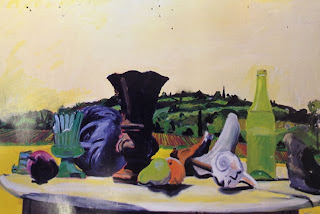I went to Skowhegan in the summer of 1972 with the Georges family. I was supposed to be Paul's assistant but the school gave me a scholarship and I went on my own. Paul was the opposition voice to Bill Pettit who was a popular color field painter of the time.
The abstract painters were much cooler somehow. Maybe because Paul had all these musty Art History books he took along with him where ever he went. He'd start talking about something and then say, "Well, we should have the Titian book." I would volunteer to go get it and others would cringe and want to leave-- Paul would yell, "get the El Greco and Breugel, too."
I made some ridiculous painting of a nude on a cow, after The Rape of Europa, it was a mess. Paul loved it and I was perfect for him to work on fixing up.
They went later in the summer, to visit the Porters on their Island in Maine and came back with two coon cats and a trailer full of furniture. The chaise they had recovered in siena colored fabric and he would paint it the rest of his life. The gold and red chairs where piled in a trailer they pulled back to the city which helped make the festive parties at the new loft.
Paul wanted me to fix the roof on the shack he kept storage. So that was my first summer out there in Sagaponac. Paul jumped right into his work and I hammered away on the cedar shakes.
Those summers between 1972 and 1976, I was around most of the time. The Watergate scandal was on TV most of the time. We painted in the mornings and then after lunch we went to the beach fishing or painting. One day we pulled James Jones' car out of the sand, Paul said he had written, From Here to Eternity, that seemed pretty cool. We'd go out to the Montauk Lighthouse to paint and to Ditch Plains. When it was windy we'd go to the Bay beach.
Soon something happened and Paul had a subject for the summer.
Maybe a model over at Una Wilkinsons where we drew with Jane Freilecher and others, or the beach rescue, which probably came from some actual grouping of people at Sag main beach.
The figures of the Lifeguards were among my favorites. I liked how their feet were dug into the sand, and "they stood there strong like young bulls," I remember remarking.
Paul started a big 10' painting and patterned it after a Breugel, in which there is a gallows that is round echoing a circle of people. In Paul's painting an umbrella does much the same.
This compositional idea always was how to present this "what happened" and it always seemed to come from what art book he was looking at-- and the ideas that streamed out from them.
I really just liked the nude sitting in the grass on the chaise lounge . The landscape always behind. These just seemed more real than life itself to me.
A small tree under a foot, making space, like he'd point out in a Valazquez painting.
He made a lot of them, though there are only a few that I've seen in a long time.
He would continue these simple nudes in the city. Somehow he wanted them to join Art with this Capital A, and he'd make this little Cupid which I never liked. I guess they were some grist like element to work into the composition.
I can tell what I liked from the work I did myself in those years. I tried to make beach paintings, and figures in the grass. I made a Kyack painting with two of me like Alex Katz. I was too shy to use Paul as the other figure. "It was Paul and I that went out fishing and almost got eaten by a shark larger than the boat." It would have been very dramatic, and I wasn't like that. I remember I liked the phrase in Berenson about Piero, that his figures were "still and unmoved, like the everlasting rocks."
I also made a huge painting called, Three Sigrids. This was in between Paul and Alex Katz. Three repeating figures but a bit more of a hint of narrative and space.
Paul and I found a dump site of a ton of wood from an old porch in the now fashionable Northwest Woods. We salvaged it and I made a fencewhich I painted on at the Foster Farm, there in the middle of Sagaponac, Imagine! I later took that apart and made a porch on the back of a barn, some new friends and I shared the next summer in Bridgehampton.
This was beside a house that Franz Kline had rented years before and had ball games with Pollock and deKooning and it was said the out house was splattered in paint by Jackson.
I had gone to Europe to visit Paulette Georges and Massacio became my new idea of what I wanted to do, I guess via Alex Katz a way to avoid being directly, a little Paul Georges. These paintings never seemed satisfactory. Dan Christensen and Larry Poons were always at the house and Klaus Kertess also saw that big elephant of a painting in the back. They all were silent. Paul though was jubilant and said he even thought I might show it in NY.
I was going to have this feeling most of my life that I was doing something different almost religious that I was inner directed, though I supported all my friends cooler seeming more relavent work. Soon I'd give way and be making more abstract work. John Chamberlain said to me, Y'ere not talkin' to anyone kid," "with those nude girly paintings."















































